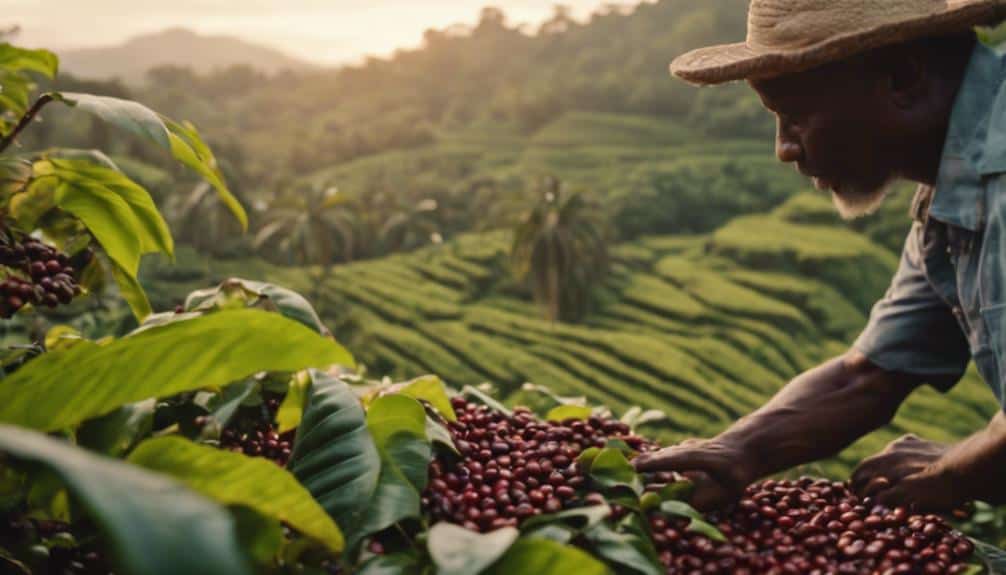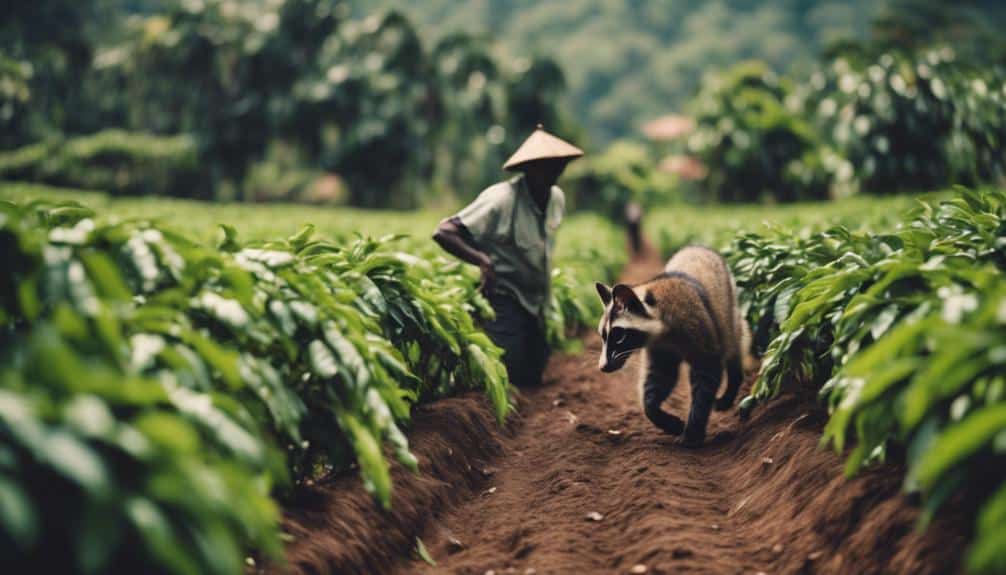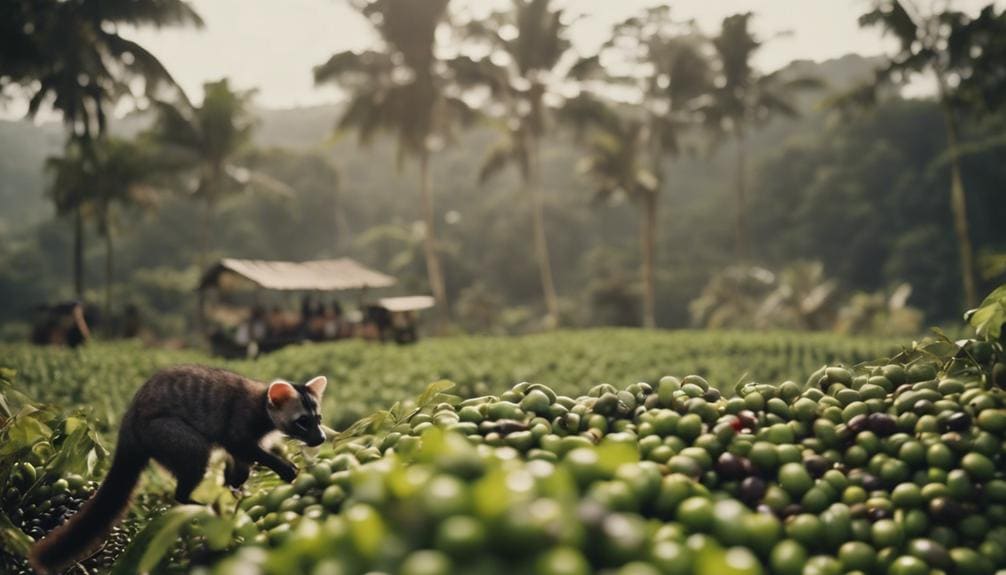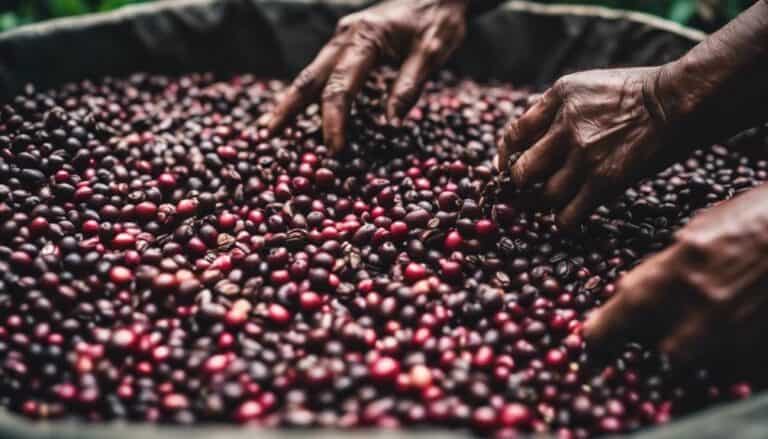Mastering the Civet Coffee Process

Mastering the Civet Coffee process demands precision and expertise at every stage. As I navigate through the intricate world of this unique coffee production, a blend of tradition and innovation unfolds. The journey from bean to cup is a fascinating exploration of craftsmanship and dedication. Stay tuned to uncover the secrets behind this extraordinary brew that captivates coffee enthusiasts worldwide.
Origin and History of Civet Coffee
Indulging in the rich history of Civet Coffee, one can't overlook the Dutch influence that sparked the discovery of this exquisite brew on the coffee plantations of Indonesia. The wild Civet, found in Southeast Asia and India, plays an essential role in the creation of Civet Coffee. These creatures naturally consume coffee cherries, digesting the fruit but excreting the beans, which are later collected and processed to produce this unique and sought-after beverage.
The Dutch, recognizing the potential of these beans, started enjoying Civet Coffee for its distinct flavor profile, which lacked the usual bitterness associated with traditional coffee. This appreciation led to the cultivation of Civet Coffee culture in various regions, including Vietnam and the Philippines, where the popularity of this specialty brew continued to grow.
Understanding the origins of Civet Coffee allows us to appreciate not only its exceptional taste but also the intricate process involved in its production, from the collection of Civet droppings to the meticulous sun-drying, dehulling, sorting, and roasting of the coffee beans. The legacy of Civet Coffee is deeply intertwined with the wild Civet and the Dutch influence that initiated its discovery, making each cup a journey through history and flavor.
Coffee Bean Selection Process
Carefully selecting the ripest and highest quality coffee cherries is an essential first step in the meticulous process of creating Civet Coffee. The journey of a coffee bean from the tree to your cup is a fascinating one, especially when it involves the unique contribution of civets. These creatures play an important role in the creation of Civet Coffee through their digestive enzymes.
As they consume the coffee cherries, the beans undergo a transformation during digestion that contributes to the distinct flavor profile Civet Coffee is known for. After being collected from the civet droppings, the coffee beans go through a thorough washing and drying process to guarantee cleanliness.
It's imperative that only beans naturally processed by the civets are selected for production, as this ensures the authentic Civet Coffee experience. Each step in the selection process is essential in preserving the integrity and quality of these exceptional coffee beans.
Ethical Considerations in Civet Coffee Production

With growing concerns over animal welfare and ethical practices, the production of Civet Coffee faces intense scrutiny and calls for responsible stewardship. The demand for this exotic brew, also known as wild Kopi Luwak, has unfortunately led to unethical practices such as force-feeding Civets to increase coffee output, raising significant animal welfare concerns.
However, there's a glimmer of hope in the form of partnerships with local tribes in the Philippines, aimed at protecting Civet habitats and promoting ethical Civet Coffee production. These initiatives are vital in shifting the narrative around Civets from once being viewed as pests to now being recognized as valuable income sources in the coffee industry.
Advocates are tirelessly fighting against cruel practices in Civet Coffee production to not only enhance the coffee's quality but also to raise ethical standards. Through collaborative efforts, strides are being made to ensure that Civet Coffee production aligns with principles of animal welfare and sustainability, paving the way for a more ethical and responsible coffee industry.
Fermentation Techniques in Civet Coffee
I've spent years refining the fermentation techniques in civet coffee production.
Yeast and bacteria play a pivotal role in breaking down the coffee cherries, enhancing the flavors.
Controlling the temperature and duration of fermentation is key to achieving that perfect balance of acidity and smoothness in each cup.
Yeast and Bacteria
Playing an important role in the fermentation process of Civet Coffee, yeast and lactic acid bacteria, naturally found in the digestive system of civet cats, contribute greatly to the distinctive flavor profile and characteristics of this prized brew.
The wild luwak's digestive system acts as a natural fermenter, enhancing the beans' flavor.
These microbes break down proteins and other compounds, influencing the coffee's aroma and taste.
The specific strains of yeast and bacteria present in the civet's gut are essential for creating the sought-after nuances in Civet Coffee.
Temperature Control
In the intricate process of crafting Civet Coffee, maintaining precise temperature control during fermentation plays an important role in revealing the beans' best flavors.
The fermentation process of civet coffee beans typically occurs within a temperature range of 25-30 degrees Celsius. This specific temperature range is essential as deviations can lead to undesirable outcomes.
High temperatures may result in over-fermentation, leading to off flavors, while low temperatures can impede the development of desirable taste profiles.
By meticulously monitoring and controlling the temperature during fermentation, we guarantee that the beans undergo the necessary transformation to achieve the unique and exquisite taste that characterizes civet coffee.
Temperature control is a fine art that influences the entire flavor profile of the final brew, making it a critical aspect of the fermentation process.
Duration of Fermentation
Fostering the ideal duration and conditions for fermentation is a pivotal aspect in honing the unparalleled flavors of civet coffee beans. When it comes to fermenting ripe coffee cherries in the civet's digestive system, timing is everything. Here's why the duration of fermentation is vital:
- 24-36 Hours: Fermentation typically lasts this long in the civet's stomach, allowing enzymes to break down proteins and sugars effectively.
- Flavor Enhancement: The process reduces bitterness and acidity, enhancing the overall flavor profile of the beans.
- Distinct Taste Development: Unique compounds produced during fermentation contribute to the sought-after, distinct taste of civet coffee, making it a truly one-of-a-kind experience.
Unique Characteristics of Civet Coffee
With its low acidity and rich chocolatey caramel flavor, civet coffee stands out as a truly unique and luxurious specialty in the world of coffee. The wild nature of civets and their selective consumption of only the ripest coffee cherries contribute to the exceptional quality of civet coffee. The enzymes in the civet's digestive system play an important role in reducing the bitterness of the beans, resulting in a smoother and more pleasant taste profile. Additionally, the fermentation process that occurs within the civet's stomach adds a distinct complexity to the coffee, giving it a character that cannot be replicated by any other method.
| Unique Characteristics of Civet Coffee | |
|---|---|
| Low Acidity | Rich Chocolatey Caramel Flavor |
| Selective Consumption by Wild Civets | Reduction of Bitterness |
| Special Fermentation Process | Luxurious and Rare Specialty |
Local Names for Kopi Luwak

Exploring the diverse cultural landscape surrounding Kopi Luwak reveals a tapestry of local names that capture the essence of this unique and revered coffee variety.
- 'Kape Alamid' in the Philippines and 'Kopi Muncak' in Bali, Indonesia, honor the tradition and craftsmanship involved in creating this exceptional brew.
- 'Cà phê Chồn' in Vietnam intricately ties the coffee to its origins, emphasizing the role of civet cats in producing quality coffee.
- 'Black Ivory Coffee' in Thailand and 'ネココーヒー' (neko kōhī) in Japan evoke images of luxury and exclusivity, emphasizing the meticulous process behind this coveted beverage.
These names not only reflect the regional diversity and rich cultural heritage but also underscore the importance of civet cats in the production of this high-quality coffee. Each name encapsulates a piece of the story behind Kopi Luwak, highlighting the meticulous care and dedication that goes into crafting this exceptional brew.
Brewing Tips for Civet Coffee
I can't stress enough the significance of controlling the brewing time when making civet coffee.
Adjusting the water temperature can truly make or break the flavors in your cup.
And let's not forget the pivotal role of grind consistency in extracting the best from your civet coffee beans.
Brewing Time Control
Crafting the perfect cup of Civet Coffee hinges on mastering the precise brewing time to reveal its rich flavors and complexities. When it comes to brewing this exquisite Coffee, every second counts. Here are three important aspects to keep in mind for brewing time control:
- Experimentation is Key: Don't be afraid to adjust the brewing time to find your ideal balance of flavors.
- Precision Matters: Follow the recommended brewing time for your chosen method to avoid over-extraction or under-extraction.
- Personalize Your Brew: Adapt the brewing time based on your taste preferences to make each cup of Luwak Coffee a unique experience.
Mastering the art of brewing time control will reveal the full potential of your Civet Coffee, allowing you to savor its nuances with every sip.
Water Temperature Adjustment
With a precise water temperature adjustment, the true essence of Civet Coffee can be revealed, showcasing its exquisite flavors and aromas in every sip.
When brewing this specialty coffee, it's essential to maintain the water temperature between 195-205°F. The Asian Palm Civet's painstaking selection of coffee cherries deserves nothing less than perfection in the brewing process.
By ensuring the water is within this ideal range, you allow for proper extraction of the rich flavors and aromas this unique coffee offers. Avoid the pitfalls of over-extraction by using water that's too hot, which can result in bitterness, or under-extraction from water that's too cold, leading to a weak brew.
Consistent water temperature is the key to bringing out the full potential of every cup of Civet Coffee.
Grind Consistency Importance
Maintaining a consistent grind size is the cornerstone of revealing the full spectrum of flavors inherent in every batch of Civet Coffee.
Each grind size, whether fine for espresso, medium for drip, or coarse for French press, plays an essential role in extracting the rich flavors of Civet Coffee.
An inconsistent grind size can result in uneven extraction, impacting the smooth flavor profile that Civet Coffee is known for.
Investing in a burr grinder guarantees precise and uniform grinding, empowering you to maximize the full potential of your Civet Cat coffee beans.
Consistency in grind size isn't just a step in the process; it's the key to a truly exceptional cup of Civet Coffee that showcases the unique essence of this exquisite brew.
Conclusion
Mastering the Civet Coffee process isn't just a skill, but a labor of love.
From meticulously selecting the finest beans to ensuring ethical practices are followed, every step is vital in creating a cup of coffee that's truly one-of-a-kind.
With its rich chocolatey caramel flavors and smooth, complex profile, Civet Coffee stands out as a unique and exceptional brew that's a tribute to the artistry and dedication of those who craft it.





